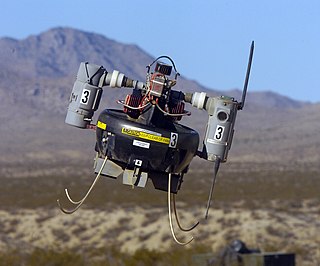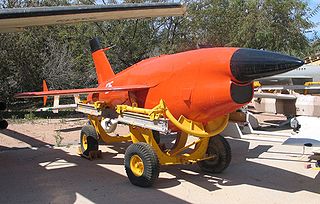
The General Atomics MQ-1 Predator is an American remotely piloted aircraft (RPA) built by General Atomics that was used primarily by the United States Air Force (USAF) and Central Intelligence Agency (CIA). Initially conceived in the early 1990s for aerial reconnaissance and forward observation roles, the Predator carries cameras and other sensors. It was modified and upgraded to carry and fire two AGM-114 Hellfire missiles or other munitions. The aircraft entered service in 1995, and saw combat in the war in Afghanistan, Pakistan, the NATO intervention in Bosnia, Serbia, the Iraq War, Yemen, the 2011 Libyan civil war, the 2014 intervention in Syria, and Somalia.

An unmanned aerial vehicle (UAV), commonly known as a drone, is an aircraft without a human pilot onboard. UAVs are a component of an unmanned aircraft system (UAS); which include a UAV, a ground-based controller, and a system of communications between the two. The flight of UAVs may operate with various degrees of autonomy: either under remote control by a human operator or autonomously by onboard computers.
Drone or drones may refer to:

Aerial photography is the taking of photographs from an aircraft or other flying object. Platforms for aerial photography include fixed-wing aircraft, helicopters, unmanned aerial vehicles, balloons, blimps and dirigibles, rockets, pigeons, kites, parachutes, stand-alone telescoping and vehicle-mounted poles. Mounted cameras may be triggered remotely or automatically; hand-held photographs may be taken by a photographer.

An unmanned combat aerial vehicle (UCAV), also known as a combat drone or simply a drone, is an unmanned aerial vehicle (UAV) that usually carries aircraft ordnance such as missiles and is used for drone strikes. Aircraft of this type have no onboard human pilot. These drones are usually under real-time human control, with varying levels of autonomy.

A micro air vehicle (MAV), or micro aerial vehicle, is a class of miniature UAVs that has a size restriction and may be autonomous. Modern craft can be as small as 5 centimeters. Development is driven by commercial, research, government, and military purposes; with insect-sized aircraft reportedly expected in the future. The small craft allows remote observation of hazardous environments inaccessible to ground vehicles. MAVs have been built for hobby purposes, such as aerial robotics contests and aerial photography.

The Ryan Aeronautical Company was founded by T. Claude Ryan in San Diego, California in 1934. It became part of Teledyne in 1969, and of Northrop Grumman when the latter company purchased Teledyne in 1999. Ryan built several historically and technically significant aircraft, including four innovative V/STOL designs, but its most successful production aircraft was the Ryan Firebee line of unmanned drones used as target drones and unmanned air vehicles.

Teleoperation indicates operation of a system or machine at a distance. It is similar in meaning to the phrase "remote control" but is usually encountered in research, academic and technical environments. It is most commonly associated with robotics and mobile robots but can be applied to a whole range of circumstances in which a device or machine is operated by a person from a distance.

The Lockheed DC-130 was a variant of the C-130 Hercules, designed for drone control. It could carry four Ryan Firebee drones underneath its wings.

Foremost is a village in southern Alberta, Canada. It is located 106 km (66 mi) south-west of Medicine Hat, along the Red Coat Trail, in the County of Forty Mile No. 8.
Unmanned underwater vehicles (UUV), sometimes known as underwater drones, are any vehicles that are able to operate underwater without a human occupant. These vehicles may be divided into two categories, remotely operated underwater vehicles (ROVs), which are controlled by a remote human operator, and autonomous underwater vehicles (AUVs), which operate independently of direct human input. The latter category would constitute a kind of robot.

A target drone is an unmanned aerial vehicle, generally remote controlled, usually used in the training of anti-aircraft crews.
The Argus As 292 was originally developed in 1939 as a small, remote-controlled unmanned anti-aircraft target drone. A short-range reconnaissance version was also developed. The success of the project led to the Argus Fernfeuer UAV proposal.
Remotely operated vehicles are vehicles which are controlled by an operator who is not in the vehicle. These can be operated by radio control, or through a cable or line connecting the vehicle to the operators location.

An unmanned vehicle or uncrewed vehicle is a vehicle without a person on board. Uncrewed vehicles can either be remote controlled or remote guided vehicles, or they can be autonomous vehicles which are capable of sensing their environment and navigating on their own.
Unmanned aircraft system simulation focuses on training pilots to control an unmanned aircraft or its payload from a control station. Flight simulation involves a device that artificially re-creates aircraft flight and the environment in which it flies for pilot training, design, or other purposes. It includes replicating the equations that govern how aircraft fly, how they react to applications of flight controls, the effects of other aircraft systems, and how the aircraft reacts to external factors such as air density, turbulence, wind shear, cloud, precipitation, etc.

A Passenger Drone is a type of Unmanned aerial vehicle (UAV) that carries passengers. The first Passenger Drone was introduced at the Consumer Electronics Show (CES) 2016 by Chinese entrepreneurs and is called the Ehang 184.

A loitering munition is a weapon system category in which the munition loiters around the target area for some time, searches for targets, and attacks once a target is located. Loitering munitions enable faster reaction times against concealed or hidden targets that emerge for short periods without placing high-value platforms close to the target area, and also allow more selective targeting as the actual attack mission can be aborted.
According to the Civil Aviation Authority of Singapore (CAAS), an unmanned aircraft (UA), commonly known as a drone, is operated without a pilot on board. An unmanned aircraft system (UAS) comprises the UA and associated elements such as the remote control equipment.












